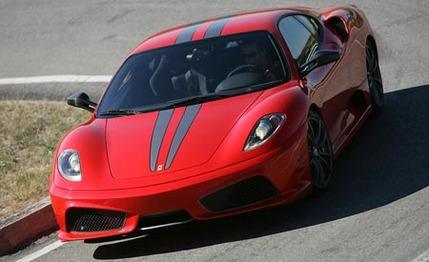
 First Drive Review
First Drive Review
The great thing about the 430 Scuderia—a faster, lighter, and even more compelling version of the F430—is that Ferrari didn’t have to make it. Automakers create new versions of their existing models to stimulate sales, but with North American waiting lists at two years for the F430, Ferrari didn’t need to drum up showroom traffic.
Ferrari people say the primary reason for building the Scuderia is that it showcases the company’s racing technology in a street car. Another reason is that, historically, Ferrari has built more extreme versions of its entry-level sports car, going back to the F355 Challenge in 1995. And Lamborghini, its northern-Italian rival, has just introduced the Gallardo Superleggera, while Porsche, its perennial competitor, is continually making go-faster versions of the 911.
Whatever the reason, enthusiasts who have well-padded bank accounts should rejoice, because the 430 Scuderia is a stunning vehicle. The engine in the F430 is a wondrous device, a snarling 4.3-liter V-8 that makes 483 horsepower. The Scuderia gets an additional 20 horsepower and an engine sound that’s so loud and enticing it causes occupants to giggle in delight. The extra power and noise come from a revised intake manifold, a freer-flowing exhaust, and a slightly higher compression ratio (up from 11.3:1 to 11.9:1), among other changes.
The F1 automated manual transmission is upgraded, too, with revised software to effect neck-wrenchingly quick shifts. Ferrari says the interval has gone from 150 milliseconds on the F430 to just 60, close to the times that its Formula 1 cars were doing a couple of years ago. Like the F430, the Scuderia has an electronically actuated clutch-pack-type differential that now works in harness with Ferrari’s latest traction-control system, F1-Trac. Carbon-ceramic composite brakes are standard, with front rotors that are 15.7 inches in diameter (up 0.7 inch over the F430’s).
Further electronic trickery includes a refinement of the F430’s so-called manettino, a rotary dial on the steering wheel that allows the driver to choose a number of regimes for the stability- and traction-control systems, gearshift speed, and shock setup. There’s a new position that turns off the traction control but retains the stability system, replacing the "ice" mode of the F430. On the F430, the shocks are set at their firmest in the more extreme, track-oriented manettino settings, but the 430 Scuderia allows the driver to soften the shocks in these racier situations.
By a variety of measures, including the liberal use of carbon fiber, a Lexan rear window, and titanium springs and wheel nuts, Ferrari says it has trimmed 221 pounds off the F430, producing a curb weight of about 3150 pounds. It is claimed that the Scuderia shaves 0.4 second off the F430’s 0-to-62-mph time of four seconds flat and that the car laps Ferrari’s Fiorano test track as fast as an Enzo.
We couldn’t confirm that claim, but we can tell you the Scuderia is indeed a track weapon, with superb handling balance, great grip, and amazing brakes. The so-called race setting is impressive, allowing a driver to mash the throttle out of turns while the electronics decide when and how to apply engine torque. The setting also allows a bit of oversteer before the stability control intervenes to prevent the driver going from apparent hero to immediate zero. On the road, the Scuderia is equally fantastic, with a tactility and immediacy that few other cars offer. The ride is outstandingly composed if the driver opts for the softer shock settings.
The F430 is a brilliant but expensive car. The 430 Scuderia is even better. And for those who think the projected price—about $250,000 when it goes on sale in the U.S. this spring—is on the extreme side, well, we reckon it’s worth every cent.